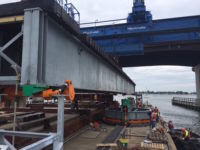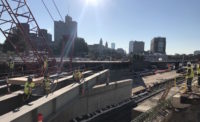

Related Links:
Massachusetts is following the lead of other states and embracing accelerated bridge construction, or ABC, using the method not only for highway spans but also for rail structures in Boston's Fairmont Corridor project.
The $174-million commuter-rail project, under way since 2004, is now in its second phase. The 9.2-mile corridor runs through urban neighborhoods south of Boston and includes construction of four new stations and three bridge replacements. Phase one, completed in 2007 for $39 million, included repairs of six bridges and improvements at three stations.
The second, $135-million phase includes four new stations, reconstruction of six bridges and a new signal system. Barletta Heavy Division Inc. holds the $15.9-million contract to build two stations and replace two related bridges. It used ABC techniques to replace both the Woodrow Avenue bridge and the Talbot Bridge last fall, says Seta Kalaijian, project manager for Barletta. Crews with multiple contractors used a self-propelled modular transporter (SPMT), with 24 axles per tractor trailer and 96 wheels, to roll each new bridge into place, she says.
For the Woodrow Avenue bridge, crews drilled 6-ft-dia shafts for 80-ft-deep bridge foundations whenever the Massachusetts Bay Commuter Railroad (MBCR) paused train service for the work. MBCR runs the trains under contract with the Massachusetts Bay Transportation Authority (MBTA), which owns the land. "We'd be drilling a caisson or getting ready for a concrete pour when, at midnight, a flagger would tell us to stop for five or six minutes to let a ghost train run by to get ready for morning service," says Scott Miles, Barletta superintendent. "To keep the hole from collapsing, we had to pace ourselves fast or slow, depending on when the train passed."
After completing foundation work, the contractor placed the new bridge on temporary supports next to the old one, says Frank Astone, senior project manager for design-engineer Jacobs Engineering. After removing the existing tracks, crews added two precast-concrete abutment caps and precast-concrete approach slabs. Then, the SPMT lowered the new bridge onto its permanent location.
Since Barletta could not locate a truck to handle delivery of 40-ft-long, 90-ton precast-concrete girders, the firm hired a concrete subcontractor to fabricate it on-site. Taking care not to bend any steel anchor rods, the operator of a 550-ton crane placed the girders.
The Woodrow Avenue Bridge replacement was completed last November, and the Talbot Bridge was completed in December. Barletta is wrapping up work on the Talbot Avenue Station, north of the Talbot Bridge. Bridge construction was completed 10 months ahead of schedule, Kalaijian says. Bernie Doherty, project manager with S&R Construction, says work on the $17.7-million Four Corners/Geneva commuter-rail station—the larger of two of its phase-two station projects—has involved much weekend work in tight conditions to install retaining walls and construct the platform while commuter trains are in operation.
"Between Washington and Geneva avenues, existing houses are up on the hill and the station is down in the valley, making it difficult to get access," Doherty says. "We have constructed soldier-pile walls, secant piles and soil-nail retaining walls in different spots to keep the earth in place." Completion is expected by December, ahead of the anticipated March 2013 deadline.
Mark Czyrklis, MBTA project manager for design and construction, says the overall program is on schedule for completion by next June. "There's been a lot of mixed-use and residential construction in anticipation of the new stations being constructed," he says.





Post a comment to this article
Report Abusive Comment